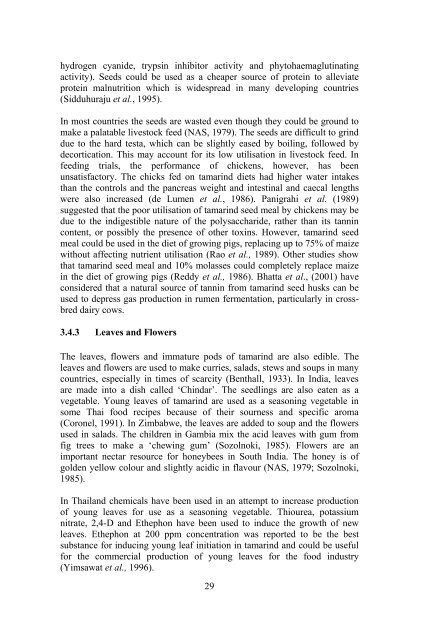Tamarind monograph.pdf - Crops for the Future
Tamarind monograph.pdf - Crops for the Future
Tamarind monograph.pdf - Crops for the Future
You also want an ePaper? Increase the reach of your titles
YUMPU automatically turns print PDFs into web optimized ePapers that Google loves.
hydrogen cyanide, trypsin inhibitor activity and phytohaemaglutinating<br />
activity). Seeds could be used as a cheaper source of protein to alleviate<br />
protein malnutrition which is widespread in many developing countries<br />
(Sidduhuraju et al., 1995).<br />
In most countries <strong>the</strong> seeds are wasted even though <strong>the</strong>y could be ground to<br />
make a palatable livestock feed (NAS, 1979). The seeds are difficult to grind<br />
due to <strong>the</strong> hard testa, which can be slightly eased by boiling, followed by<br />
decortication. This may account <strong>for</strong> its low utilisation in livestock feed. In<br />
feeding trials, <strong>the</strong> per<strong>for</strong>mance of chickens, however, has been<br />
unsatisfactory. The chicks fed on tamarind diets had higher water intakes<br />
than <strong>the</strong> controls and <strong>the</strong> pancreas weight and intestinal and caecal lengths<br />
were also increased (de Lumen et al., 1986). Panigrahi et al. (1989)<br />
suggested that <strong>the</strong> poor utilisation of tamarind seed meal by chickens may be<br />
due to <strong>the</strong> indigestible nature of <strong>the</strong> polysaccharide, ra<strong>the</strong>r than its tannin<br />
content, or possibly <strong>the</strong> presence of o<strong>the</strong>r toxins. However, tamarind seed<br />
meal could be used in <strong>the</strong> diet of growing pigs, replacing up to 75% of maize<br />
without affecting nutrient utilisation (Rao et al., 1989). O<strong>the</strong>r studies show<br />
that tamarind seed meal and 10% molasses could completely replace maize<br />
in <strong>the</strong> diet of growing pigs (Reddy et al., 1986). Bhatta et al., (2001) have<br />
considered that a natural source of tannin from tamarind seed husks can be<br />
used to depress gas production in rumen fermentation, particularly in crossbred<br />
dairy cows.<br />
3.4.3 Leaves and Flowers<br />
The leaves, flowers and immature pods of tamarind are also edible. The<br />
leaves and flowers are used to make curries, salads, stews and soups in many<br />
countries, especially in times of scarcity (Benthall, 1933). In India, leaves<br />
are made into a dish called ‘Chindar’. The seedlings are also eaten as a<br />
vegetable. Young leaves of tamarind are used as a seasoning vegetable in<br />
some Thai food recipes because of <strong>the</strong>ir sourness and specific aroma<br />
(Coronel, 1991). In Zimbabwe, <strong>the</strong> leaves are added to soup and <strong>the</strong> flowers<br />
used in salads. The children in Gambia mix <strong>the</strong> acid leaves with gum from<br />
fig trees to make a ‘chewing gum’ (Sozolnoki, 1985). Flowers are an<br />
important nectar resource <strong>for</strong> honeybees in South India. The honey is of<br />
golden yellow colour and slightly acidic in flavour (NAS, 1979; Sozolnoki,<br />
1985).<br />
In Thailand chemicals have been used in an attempt to increase production<br />
of young leaves <strong>for</strong> use as a seasoning vegetable. Thiourea, potassium<br />
nitrate, 2,4-D and E<strong>the</strong>phon have been used to induce <strong>the</strong> growth of new<br />
leaves. E<strong>the</strong>phon at 200 ppm concentration was reported to be <strong>the</strong> best<br />
substance <strong>for</strong> inducing young leaf initiation in tamarind and could be useful<br />
<strong>for</strong> <strong>the</strong> commercial production of young leaves <strong>for</strong> <strong>the</strong> food industry<br />
(Yimsawat et al., 1996).<br />
29

















